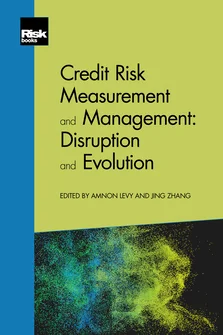The Quest to Save Risk-Weighted Assets
Christopher Finger
Foreword
Introduction
An Exploration of the Evolution of Risk: Past, Present and Future
Risk Trading, Risky Debt and Financial Stability
Skating on Thinner Ice: A Macroeconomic Outlook at the End of the Credit Cycle
Climate Change: Managing a New Financial Risk
The Quest to Save Risk-Weighted Assets
The Evolution of the CLO Market since the Global Financial Crisis and a Valuation Approach for CLO Tranches
Homo Ex Machina: Finance Rebooted
Innovation and Digitisation in Credit: A Global Perspective
The Lending Revolution: How Digital Credit Is Changing Banks from the Inside
Digital Lending in Asia: Disruption and Continuity
Digitisation and Automation in Commercial Lending: Disruption without Distraction
Credit Risk Management in the Era of Big Data: From Measurement to Insight
Artificial Intelligence and Machine Learning in Credit Risk Analytics: Present, Past and Future
Integrated Loan Portfolio Modelling and Risk Management
The Role of Banks in Illiquid Credit Markets, and the Disruption and Evolution of Credit Portfolio Management
Epilogue
Since the 1980s, global banking supervisors, working through the Basel Committee on Banking Supervision, have agreed to a succession of standards for regulation of internationally active banks. At the core of these standards is the risk-based framework for setting minimum capital requirements. Although the effectiveness of these standards has been tested over the years by local events, the global financial crisis of 2007–9 exposed significant weaknesses in the framework. Supervisors globally have worked since the crisis to reform the standards, with the goal of ensuring banks’ safety, addressing systemic financial risks and re-establishing the credibility of the risk-weighted assets (RWA) framework with the public.
We begin with a short history of the successive global capital frameworks, and the primary motivations for each reform. Then we discuss the weaknesses of the prevailing framework that were exposed by the financial crisis. The most recent reforms to the capital framework are then introduced, with a discussion of how these reforms are intended to address the problems of the prior regime. Finally, we lay out a series of approaches by which supervisors could evaluate
Copyright Infopro Digital Limited. All rights reserved.
As outlined in our terms and conditions, https://www.infopro-digital.com/terms-and-conditions/subscriptions/ (point 2.4), printing is limited to a single copy.
If you would like to purchase additional rights please email info@risk.net
Copyright Infopro Digital Limited. All rights reserved.
You may share this content using our article tools. As outlined in our terms and conditions, https://www.infopro-digital.com/terms-and-conditions/subscriptions/ (clause 2.4), an Authorised User may only make one copy of the materials for their own personal use. You must also comply with the restrictions in clause 2.5.
If you would like to purchase additional rights please email info@risk.net











